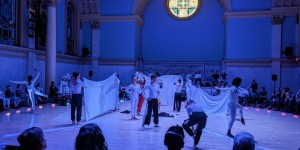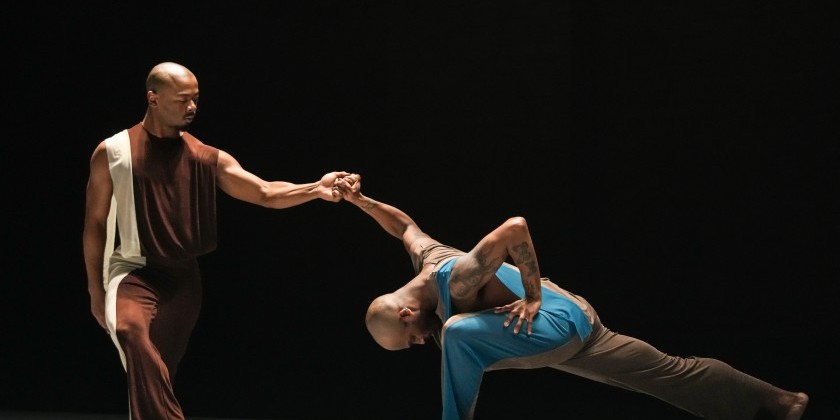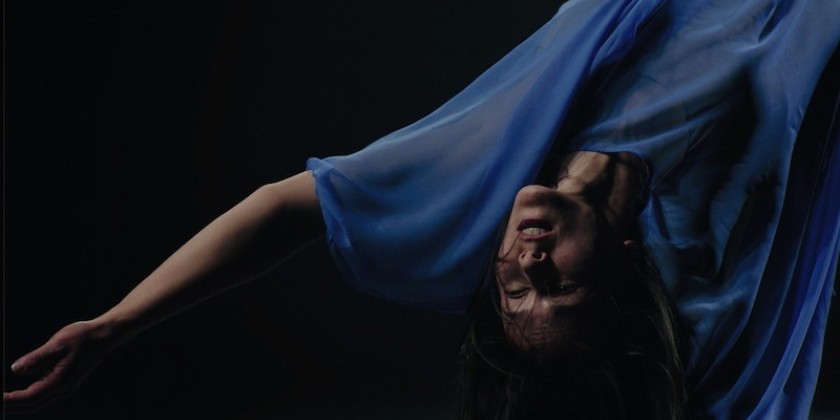
IMPRESSIONS: A Trio of Dance Films Curated by MOVING VISIONS Editor Francesca Harper, Featuring Maleek Washington's "Shadow," Willy Laury's "Aurum I: A Memory Film," and Baye & Asa's "Second Seed"

Covid-19 has changed our perspectives and practices. School classes, work meetings, doctor appointments, dates, parties, and holiday dinners have moved to Zoom. Today our personal and professional endeavors are increasingly conducted on-screen. Many in the dance world have shifted from live performance in still dark theaters to their own screen explorations. Behind the malleable lens of the camera, choreographers can manipulate dance in ways impossible in real-time.
Three promising dance artists (Maleek Washington, Eriko Iisaku, and Sam Asa Pratt) were chosen to be featured by The Dance Enthusiast’s MOVING VISIONS editor, Francesca Harper. They perform and create gripping narratives that highlight the unique opportunities dance on film offers.
MALEEK WASHINGTON
Shadow
Choreographer: Maleek Washington // Director/Editor: Michael Robayo // Original Music: Marcus Gilmore
Shooters: Michael Robayo, Stanley Rojas // Production Company: Site B Studios
Maleek Washington stands alone in the dirt under an overpass. His arms reach out to gather the air around him, pulling it close to his heart. Softly, he coils and uncoils his body, moving with the lilting notes of Marcus Gilmore’s piano composition.
Images solidify — bound wrists, splayed fingers, undulating shoulders — symbols of police brutality and a man fighting forces outside of his control. The camera rotates around Washington as he melts, heightening a sense of surrender, not to violence or stereotype, but to life’s inner beauty and fleeting nature.

The overpass dwarfs Washington, its towering stone pylons offering shadowed places to move just beyond the reach of sunlight. His upward gaze suggests a longing to ascend, while sudden backward hinges reinforce his confinement to this place.
The camera cuts between moments of dancing, both tense and free, revealing a man mining and digesting his experiences of being Black in the United States of America. As the lights of a cop car appear in the distance, the camera zooms out and Washington’s figure, still strong and centered, recedes.
ERIKO IISAKU
Aurum I: A Memory Film
Choreography: Willy Laury // Direction: Max R. A. Fedore // Original Score: Nathan Prillaman
Production Design: Griffin Stoddard // Cinematography: Oren Soffer
Dancers: Eriko Iisaku, Willy Laury, Scott Schneider, Łukasz Zięba, and Emma Caymares
Willy Laury, choreographer, and Max R. A. Fedore, director, with their artistic team, explore the idea of collective memory in a sci-fi world that would be challenging to create for the proscenium stage. Here, four telepaths are summoned to participate in a sacred ritual. Communicating without speaking, touching, or always being in the same room, they unite to choose a new vessel who will preserve the memory of humankind. For fans of the TV series Sense8. Fedore pulls us into the action in much the same manner. In rapid cuts, from scene to scene, the characters psychically experience each other’s lives.
A tattoo of small circles on each of the telepath’s arms binds them. Standing in front of a hotel mirror, Eriko Iisaku lifts her arms to cover her face. As she caresses her tattoo, Laury, in a park far away, does the same. When he breaks his shape, Iisaku dissolves her arms in bewilderment.

Scott Schneider pushes invisible hands away, his face registering confusion, then annoyance, as Lukasz Zieba hustles strangers in a hotel bed. When one dancer moves, their counterpart responds, transferring memory and sensation across time and space. As the camera flies, the choreography morphs, and we encounter vital realizations along with the performers.
The lighting and framing of Aurum l: A Memory create a realm beyond physical reality that’s not quite a dream. Isolated movements- a writhing shoulder, an exposed chest — beautifully guide our eye through this futuristic, yet primitive, rite of passage.
SAM PRATT
Second Seed
Directed & Choreographed by Amadi Baye Washington & Sam Asa Pratt, aka Baye & Asa
Edited: Baye & Asa // Production & Music: Jack Grabow // Cinematography: Alan Jensen
Technical Director: David Bull // Colorist: Corey Ryan
Cast: AJ Tasley Parr: Child // Myssi Robinson: Woman #1 // Marla Phelan: Woman #2
Amadi Baye Washington: Man #1 // Sam Asa Pratt: Man #2
Memory turns delusional in Baye and Asa’s Second Seed, a response to D.W. Griffith’s 1915 silent film The Birth of a Nation. Griffith’s film has been notable since its release both for its innovation (the first-ever feature-length film of its day) and its horrible employment of the art of cinema to vilify an entire race. White actors in blackface were used to portray African-American men as unintelligent, sexually aggressive predators of white women.
Today, 106 years after Griffith’s premiere, the issue of racism is still disturbingly pertinent. A year after Breonna Taylor’s murder, with the public’s screams for justice yet to be answered, with the eruption of nationwide Black Lives Matter protests following the killing of George Floyd, and on the heels of a hate crime that left six Asian women dead in Atlanta, Georgia, Second Seed begs the question: will the delusion of white supremacy ever cease?
Directors and Choreographers Amadi Baye Washington and Sam Asa Pratt, lifelong friends who grew up in New York City, do not answer that question, but rather confront viewers with poignant and difficult imagery to wrestle with.

Where Griffith’s film presents the Ku Klux Klan, the most obvious external representation of white supremacy, as a heroic force necessary to preserve American values (in fact, Birth of a Nation is credited with the resurgence of the Klan), Baye and Asa illustrate how the disease of racial supremacy destroys us all. As we watch a family descend into madness, we are forced to question our own place in a macrocosm that continually fails and marginalizes people.
Switching between the backwoods of Somewhere, USA, and a black box theater, Second Seed alters time and space, zeroing in on relationships and exposing fear, confusion, and mistrust.
Through the trees, a young white girl (AJ Tasley Parr) runs, seemingly being chased by a Black man and woman. However, when she arrives in a small clearing, we realize these people were actually running to one another. The three are friends, and Parr reaches to embrace Myssi Robinson and Amadi Baye Washington.
Discovering the trio, Sam Asa Pratt, portraying Parr’s father, pushes his daughter away from her friends. Parr’s mother, portrayed by Marla Phelan, catches her daughter sharply by the neck, then softens to embrace her. We can’t help but sense the parents’ bigotry and duplicitous nature.

When the film moves into the black box space, the parents reveal their dark rage and need for control. Pratt grabs Washington roughly by the hand, then leads him offstage by the scruff of his neck. Phelan’s pale hand emerges from the darkness, a gesture of menace and dominion, forcing Robinson into fearful panic. Love and change, however, are impossible to stop. Despite all redirection, Parr and Washington, when alone on the red-lit stage, explore their longing, intimacy, and sensuality.
She repeatedly falls into his arms, yet the partners assert individuality, pushing and pulling each other until they finally couple. Parr’s parents find out and are enraged. The camera shows us close-ups of Parr’s torso as she is dragged through the dirt by her father. The ability of the camera to sharply focus our attention gives this an urgency unavailable on stage, where we are proximally removed from the action. The scene shifts are dizzying until Pratt, his face wrathful, chokes his daughter. We are so close we are almost participants in this violent act.
Parr symbolizes America’s founding ideals: liberty, freedom, and equality. Her union with Washington, which suggests the possibility of melding cultures, policies, and families, is destroyed by a hatred that has no apparent cause. This idea of colors and cultures merging surely threatened the notion of a “white race” after the Civil War and into the Reconstruction era, Second Seed asks, are we still threatened today?














